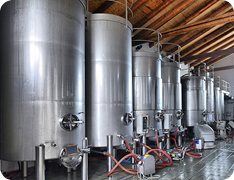 Many California wineries are ramping up their production volumes to near prerecession levels. As a result, they may be unknowingly increasing their tax liabilities—but lucky enough, California now provides a partial sales and use tax exemption that could help offset the increase.
Many California wineries are ramping up their production volumes to near prerecession levels. As a result, they may be unknowingly increasing their tax liabilities—but lucky enough, California now provides a partial sales and use tax exemption that could help offset the increase.
The partial exemption is available to businesses engaged in R&D or qualified manufacturing activities. That may not sound quite like your winery, but on a closer look it applies to many of the activities wineries regularly engage in.
The partial exemption became effective July 1, 2014, and applies to the purchase or lease of qualified property primarily used in these qualified activities by a qualified person. Although the applicable laws are somewhat more complex, qualified property is generally defined as tangible personal property used in a qualified activity that has a useful life of greater than one year.
In regards to the actual benefit, the partial exemption reduces the tax rate on these qualified expenditures by approximately 55 percent, with a rate reduction of a little under 4.2 percent. Since the current statewide tax rate is 7.5 percent, the partial exemption reduces the sales tax on qualifying property sold to a qualified person to a rate of just over 3.3 percent, plus any applicable district taxes. Simply put, $1 million in qualified expenditures would result in an immediate $42,000 of above-the-line savings.
What Activities and Purchases Qualify?
Most wineries will find that their production falls into California’s definition of manufacturing. Moreover, if you’re building a new winery production facility, many of the construction costs may also qualify to generate tax savings.
If your winery does qualify for the incentive, you’ll need to complete an exemption certificate specific to this program and provide it to your construction vendor for a reduced tax rate.
Purchases of the following items likely qualify for the partial exemption:
- Crushers
- Stainless steel fermentation tanks
- Bottle washers
- Laboratory testing equipment
The construction of barrel buildings and other special purpose buildings also potentially qualify for the partial exemption. The following three categories of property, on the other hand, are ineligible for the partial exemption:
- Consumables with a useful life of less than one year. This would include chemicals, such as gelatin, bentonite, and sulfur dioxite, which are used as manufacturing aids.
- Furniture and equipment used to store completed wine. This would include forklifts or dollies used to move finished wine from storage to the loading docks.
- Administrative and general management or marketing property. This would include tasting room furnishings, computers used in your accounting office, and display racks.
Benefits and Challenges
Odds are you aren’t purchasing wine production equipment solely for the pleasure of claiming the partial exemption. You’re growing, improving your products, and becoming more sophisticated as a business, which means every dollar you can save on taxes is a dollar you can reinvest toward your long-term goals.
Though the partial exemption isn’t intended to be difficult to claim, there are a few areas where wineries can get snagged. Some of the issues that may come up as you pursue the exemption include:
- Difficulty recouping overpayments. Since the incentive was enacted, many wineries have continued to pay tax as if the incentive didn’t exist, meaning they’ve already overpaid tax on qualified expenditures. Most aren’t aware of how to recoup these overpayments.
- Pushback from vendors. Because many businesses aren’t aware of the incentive, wineries and other manufacturers attempting to purchase qualified property are encountering resistance from their vendors, which don’t necessarily know (or believe) that this partial exemption even exists.
- Rates passed down through contractors. When performing work for a qualified business, a construction contractor may purchase some materials at the reduced or partially exempt tax rate, passing that benefit on to the customer. The rules that govern construction contractors are complex, and as a result this issue has been hotly debated on a number of fronts.
Next Steps
The first step in claiming the partial exemption is to document your qualification for it. Then, you’ll need to complete the Partial Exemption Certificate for Manufacturing, Research and Development Equipment (Form BOE-230-M or BOE-230-MC), and provide that certificate to your vendor.
If you purchase equipment from a non-California retailer that doesn’t collect California sales and use tax, report the purchase on your California sales and use tax return, where there’s a section specifically for partial exemptions.
You may create an exemption certificate for each specific purchase you plan to make, or you can choose to create a blanket certificate. If you’re purchasing from a vendor that provides both equipment and consumables, creating an exemption certificate for each individual purchase will help you make sure you’re taking the partial exemption only on qualified items.
We're Here to Help
It’s nice to finally see California provide a real cash incentive that isn’t tied to an income tax return. Our state and local tax professionals have helped clients resolve many of the challenges associated with claiming this new partial exemption, and we’ve also helped them pursue other planning opportunities related to this incentive. Contact your Moss Adams tax professional for more information on whether your operations may qualify and for help claiming the exemption.